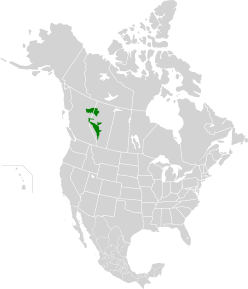Alberta-British Columbia foothills forests
| Alberta-British Columbia foothill forests | |
|---|---|
 | |
| Ecology | |
| Biome | Temperate coniferous forests |
| Bird species | 182[1] |
| Mammal species | 61[1] |
| Geography | |
| Area | 120,500 km2 (46,500 sq mi) |
| Country | Canada |
| Conservation | |
| Habitat loss | 5.0598%[1] |
| Protected | 47%[1] |
The Alberta-British Columbia foothills forests are a temperate coniferous forests ecoregion of Canada. This ecoregion borders Canada's taiga and contains a mix of subarctic forest and temperate forest species as a result. This makes the region an ecotone region, or a region that acts as a buffer between two other biomes.
Setting
This ecoregion covers two separate areas: the rolling foothills of the Rocky Mountains in Alberta, and further west a smaller area of the hills and valleys of central British Columbia. The Clear Hills in the north of the region are steeper.[2]
Average annual temperature vary from -0.5°C to 2°C, with the summer temperatures around 14°C dropping in winter to -17.5°C in the north and -10°C in the south.
Flora
The forests are a mixture dominated by lodgepole pine (Pinus contorta), jack pine (Pinus banksiana), trembling aspen (Populus tremuloides), black spruce (Picea mariana), and white spruce (Picea glauca). Other trees include balsam poplar (populus balsamifera), paper birch (Betula papyrifera) and balsam fir (Abies balsamifera).
Fauna
These foothills are home to the largest herds of moose (Alces alces) in North America. Not only are the moose plentiful, but there are two subspecies of moose: the smaller Shiras moose (Alces alces shirasi) of the Rocky Mountains and the larger western moose (Alces alces andersoni) of Canada. It is not known if the two subspecies hybridize in areas where they meet.
Other mammals include snowshoe hare (Lepus americanus), reindeer (ranigfer tarandus), North American beaver (Castor canadensis), muskrat (Ondatra zibethica), grey wolf (Canis lupus) and two subspecies of American black bear the cinnamon bear (Ursus americanus cinnamomum) of the Rocky Mountains and the eastern black bear (Ursus americanus americanus) of the Canadian Taiga.
Birds of the area include sandhill cranes (Grus canadensis), ruffed grouse (Bonasa umbellus), spruce grouse (Falcipennis canadensis) and large numbers of waterbirds and New World warblers (Parulidae).
Threats and preservation
These forests have been extensively altered by human activity, especially clearance for planting.
References
- 1 2 3 4 Hoekstra, J. M.; Molnar, J. L.; Jennings, M.; Revenga, C.; Spalding, M. D.; Boucher, T. M.; Robertson, J. C.; Heibel, T. J.; Ellison, K. (2010). Molnar, J. L., ed. The Atlas of Global Conservation: Changes, Challenges, and Opportunities to Make a Difference. University of California Press. ISBN 978-0-520-26256-0.
- ↑ "Alberta-British Columbia foothills forests". Terrestrial Ecoregions. World Wildlife Fund.